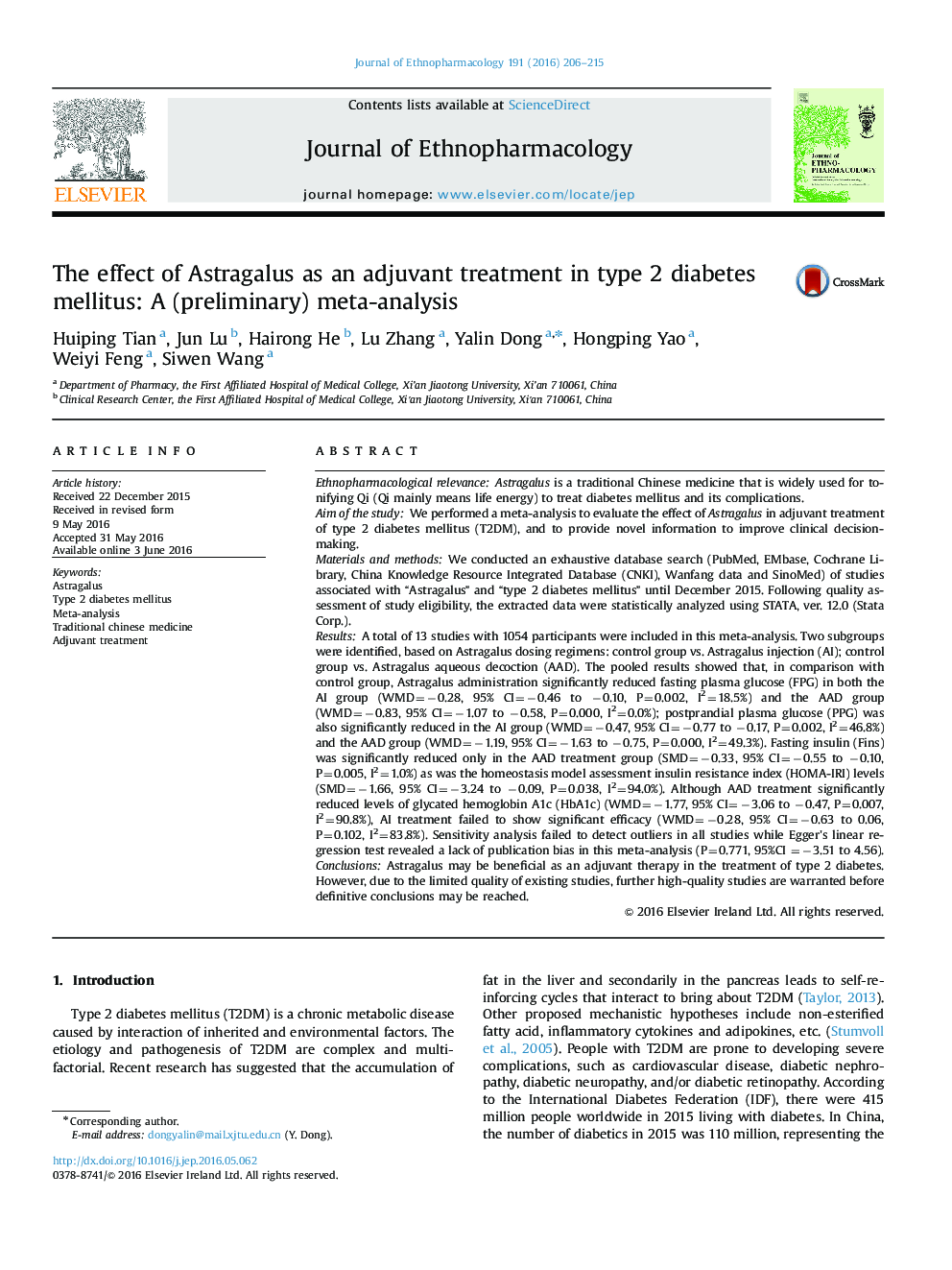| کد مقاله | کد نشریه | سال انتشار | مقاله انگلیسی | نسخه تمام متن |
|---|---|---|---|---|
| 2544586 | 1560371 | 2016 | 10 صفحه PDF | دانلود رایگان |

Ethnopharmacological relevanceAstragalus is a traditional Chinese medicine that is widely used for tonifying Qi (Qi mainly means life energy) to treat diabetes mellitus and its complications.Aim of the studyWe performed a meta-analysis to evaluate the effect of Astragalus in adjuvant treatment of type 2 diabetes mellitus (T2DM), and to provide novel information to improve clinical decision-making.Materials and methodsWe conducted an exhaustive database search (PubMed, EMbase, Cochrane Library, China Knowledge Resource Integrated Database (CNKI), Wanfang data and SinoMed) of studies associated with “Astragalus” and “type 2 diabetes mellitus” until December 2015. Following quality assessment of study eligibility, the extracted data were statistically analyzed using STATA, ver. 12.0 (Stata Corp.).ResultsA total of 13 studies with 1054 participants were included in this meta-analysis. Two subgroups were identified, based on Astragalus dosing regimens: control group vs. Astragalus injection (AI); control group vs. Astragalus aqueous decoction (AAD). The pooled results showed that, in comparison with control group, Astragalus administration significantly reduced fasting plasma glucose (FPG) in both the AI group (WMD=−0.28, 95% CI=−0.46 to −0.10, P=0.002, I2=18.5%) and the AAD group (WMD=−0.83, 95% CI=−1.07 to −0.58, P=0.000, I2=0.0%); postprandial plasma glucose (PPG) was also significantly reduced in the AI group (WMD=−0.47, 95% CI=−0.77 to −0.17, P=0.002, I2=46.8%) and the AAD group (WMD=−1.19, 95% CI=−1.63 to −0.75, P=0.000, I2=49.3%). Fasting insulin (Fins) was significantly reduced only in the AAD treatment group (SMD=−0.33, 95% CI=−0.55 to −0.10, P=0.005, I2=1.0%) as was the homeostasis model assessment insulin resistance index (HOMA-IRI) levels (SMD=−1.66, 95% CI=−3.24 to −0.09, P=0.038, I2=94.0%). Although AAD treatment significantly reduced levels of glycated hemoglobin A1c (HbA1c) (WMD=−1.77, 95% CI=−3.06 to −0.47, P=0.007, I2=90.8%), AI treatment failed to show significant efficacy (WMD=−0.28, 95% CI=−0.63 to 0.06, P=0.102, I2=83.8%). Sensitivity analysis failed to detect outliers in all studies while Egger's linear regression test revealed a lack of publication bias in this meta-analysis (P=0.771, 95%CI =−3.51 to 4.56).ConclusionsAstragalus may be beneficial as an adjuvant therapy in the treatment of type 2 diabetes. However, due to the limited quality of existing studies, further high-quality studies are warranted before definitive conclusions may be reached.
As an adjuvant treatment, Astragalus might be beneficial in reducing FPG, PPG, HbA1c and Fins levels, and HOMA-IRI. It is probably contribute to blood glucose control in patients with T2DM and provide references for clinical decision.Figure optionsDownload high-quality image (157 K)Download as PowerPoint slide
Journal: Journal of Ethnopharmacology - Volume 191, 15 September 2016, Pages 206–215